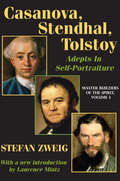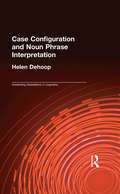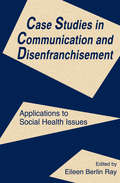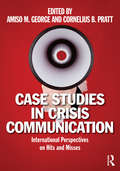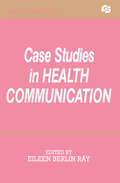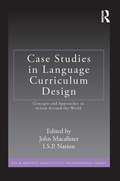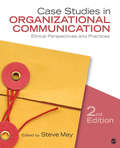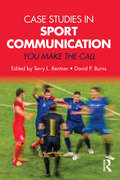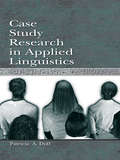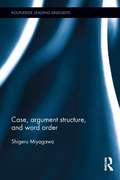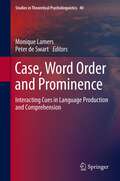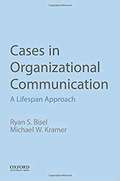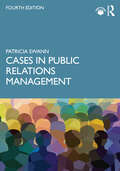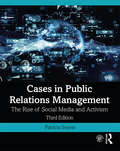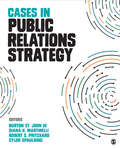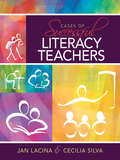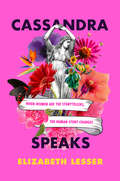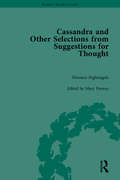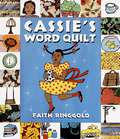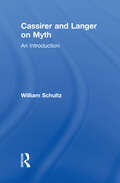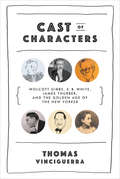- Table View
- List View
Casanova, Stendhal, Tolstoy: Volume 3, Master Builders of the Spirit
by Jay KatzCasanova, Stendhal, Tolstoy: Adepts in Self-Portraiture, the final volume of Stefan Zweig's masterful Master Builders of the Spirit trilogy, discloses the smaller version of a writer's own ego. Unconscious though it is, no reality is as important to the writer as the reality of their own life. Giacomo Casanova, Stendhal (Marie-Henri Beyle), and Leo Tolstoy have different approaches to self-portraiture, but Zweig shows that together they symbolize three levels which represent successively ascending gradations of the same creative function.Casanova is depicted as having a primitive gradation; he simply records deeds and happenings, without any attempt to appraise them or to study the deeper working of the self. Stendhal's self-portraiture is depicted as psychological; he observes himself and investigates his own feelings. Tolstoy has the highest level; he describes his own life, records what led him to his own actions, and focuses on self-reflection in a completely unexaggerated manner.At first glance it might seem as if self-portraiture is an artist's easiest task. With no further trouble than a probing of memory and a description of the facts of life, "the truth" is revealed. The history of literature shows that ordinary autobiographers are no more than commonplace witnesses testifying to facts that chance has brought to their knowledge. A practiced artist is needed to discern the innermost happenings of the soul; few who have attempted autobiography have been successful in this difficult task. The present volume expounds the characteristics of these subjectively minded artists, and of autobiography as their typical method of personal expression.
Case Configuration and Noun Phrase Interpretation (Outstanding Dissertations in Linguistics)
by Helen DehoopFirst Published in 1997. Routledge is an imprint of Taylor & Francis, an informa company.
Case Studies in Communication and Disenfranchisement: Applications To Social Health Issues (Routledge Communication Series)
by Eileen Berlin RaySee blurb for Communication and Disenfranchisement. Books will be promoted together.
Case Studies in Crisis Communication: International Perspectives on Hits and Misses
by Amiso M. George Cornelius B. PrattCase Studies in Crisis Communication: International Perspectives on Hits and Misses was created to fill the gap for a much-needed textbook in case studies in crisis communication from international perspectives. The events of September 11, 2001, other major world crises, and the ongoing macroeconomic challenges of financial institutions, justify the need for this book. While existing textbooks on the subject focus on U.S. corporate cases, they may not appeal equally to students and practitioners in other countries, hence the need to analyze cases from the United States and from other world regions. The variety and the international focus of the cases, be they environmental, health or management successes or failures, makes this book more appealing to a wider audience. These cases examine socio-cultural issues associated with responding to a variety of crises.
Case Studies in Health Communication: A Case Study Approach (Routledge Communication Series)
by Eileen Berlin RayThis book focuses on the complexities of the communication of health-related messages and information through the use of case studies. The expert contributors to this volume are scholars who, during their research and consulting, grapple with many of the issues of concern to those studying health communication. While several introductory books offer brief case studies to illustrate concepts covered, this book provides in-depth cases that enable more advanced students to apply theory to real situations.
Case Studies in Language Curriculum Design: Concepts and Approaches in Action Around the World (ESL & Applied Linguistics Professional Series)
by John Macalister I.S.P. NationCase studies are a powerful pedagogical tool for illuminating constructs and models in real-life contexts. Covering a wide range of teaching-learning contexts and offering in-depth analyses of ESL/ELT language curriculum design issues, this casebook is distinctive and unique in that each case draws on and is clearly linked to a single model presented in Nation and Macalister’s Language Curriculum Design (www.routledge.com/9780415806060), giving the book a high degree of coherence. A short commentary by the editors after each case highlights features of note and/or issues arising from it. This is a versatile text, designed to work as a companion to Language Curriculum Design (adding meaning and depth to the model presented there by relating it to a range of applications), as a stand-alone text, or as a resource for language teacher trainees, teacher educators, practicing teachers, program administrators, and materials writers in the field.
Case Studies in Organizational Communication: Ethical Perspectives and Practices
by Steve MayThe Second Edition of Case Studies in Organizational Communication: Ethical Perspectives and Practices, by Dr. Steve May, integrates ethical theory and practice to help strengthen readers' awareness, judgment, and action in organizations by exploring ethical dilemmas in a diverse range of well-known business cases.
Case Studies in Sport Communication: You Make the Call
by Terry L. Rentner David P. BurnsCase Studies in Sport Communication: You Make the Call goes beyond the box scores by offering readers the opportunity to evaluate popular and diverse issues in sport—including management, crisis, health, ethics, gender, race, and social media. Each chapter incorporates theory and communication principles as well as topical background information, and concludes with discussion questions and engaging assignments. This volume presents real-life, provocative sports cases that bring contemporary headlines into perspective and inspire critical thinking. Each chapter features scholarly evidence that will keep the conversation lively, thoughtful, and informative. Students are encouraged to challenge the ethical implications of what they have read and to “make the call.” This is an invaluable resource for upper-level undergraduate and graduate students of sport communication and sport management.
Case Study Research in Applied Linguistics (Second Language Acquisition Research Ser.)
by Patricia DuffCase studies of individual language learners are a valuable means of illustrating issues connected with learning, using, and in some cases, losing another language. Yet, even though increasing numbers of graduate students and scholars conduct research using case studies or mix quantitative and qualitative methods, there are no dedicated applied lin
Case, Argument Structure, and Word Order (Routledge Leading Linguists)
by Shigeru MiyagawaOver the years, a major strand of Miyagawa's research has been to study how syntax, case marking, and argument structure interact. In particular, Miyagawa's work addresses the nature of the relationship between syntax and argument structure, and how case marking and other phenomena help to elucidate this relationship. In this collection of new and revised pieces, Miyagawa expands and develops new analyses for numeral quantifier stranding, ditransitive constructions, nominative/genitive alternation, "syntactic" analysis of lexical and syntactic causatives, and historical change in the accusative case marking from Old Japanese to Modern Japanese. All of these analyses demonstrate an intimate relation among case marking, argument structure, and word order.
Case, Word Order and Prominence: Interacting Cues in Language Production and Comprehension (Studies in Theoretical Psycholinguistics #40)
by Monique Lamers Peter De SwartLanguage users have access to several sources of information during the build up of a meaningful construction. These include grammatical rules, situational knowledge, and general world knowledge. A central role in this process is played by the argument structure of verbs, which establishes the syntactic and semantic relationships between arguments. This book provides an overview of recent psycholinguistic and theoretical investigations on the interplay between structural syntactic relations and role semantics. The focus herein lies on the interaction of case marking and word order with semantic prominence features, such as animacy and definiteness. The interaction of these different sorts of information is addressed from theoretical, time-insensitive, and incremental perspectives, or a combination of these. Taking a broad cross-linguistic perspective, this book bridges the gap between theoretical and psycholinguistic approaches to argument structure.
Cases in Organizational Communication: A Lifespan Approach
by Ryan S. Bisel Michael W. KramerCase Studies in Organizational Communication: A Lifespan Approach is the first collection of its kind that is designed to complement a textbook (the editors' Organizational Communication: A Lifespan Approach, OUP, 2016). Bringing concepts to life by engaging readers' minds, memories, and emotions, this volume provides students and instructors with a wealth of opportunities to see, hear, and feel how communication can and does shape organizations and the experiences of people within them.
Cases in Public Relations Management
by Patricia SwannThis fourth edition of Cases in Public Relations Management features a combination of new and tried-and-tested cases that give students a practical view of how on-the-ground public relations is practiced today.Showcasing both successes and failures in public relations management, this text uses a problem-based case study approach that encourages readers to put their knowledge to the test to assess what has worked and consider alternate approaches to the situations these cases explore. It features questions for discussion and prompts to “dig deeper” into the cases at hand. New to the fourth edition: Fifteen new cases, including Anheuser-Busch InBev, Dove, Juul, FTX, Norfolk Southern, Barbie, and Nike Emphasis on social media, sustainability, ethics, and social responsibility for communication management today End-of-chapter activities that reinforce concepts Developed for advanced students in strategic communication and public relations, this book prepares them for their future careers as communication and public relations professionals.The fourth edition features fully updated online resources: student case guides with case supplements, instructor case guides with sample answers to end of case questions in the text, and PowerPoint lecture slides. Please visit www.routledge.com/9781032163642.
Cases in Public Relations Management: The Rise of Social Media and Activism
by Patricia SwannNow in its third edition, Cases in Public Relations Management uses recent cases in strategic communication designed to encourage discussion, debate, and exploration of the options available to today's strategic public relations manager, with the help of extensive supplemental materials. Key features of this text include coverage of the latest controversies in current events, discussion of the ethical issues that have made headlines in recent years, and strategies used by public relations practitioners. The problem-based case study approach encourages readers to assess what they know about communication theory, the public relations process, and management practices. New to the third edition: Eighteen new cases including Snap, Wells Fargo, SeaWorld, United Airlines, and Starbucks. Additional emphasis on social media and social responsibility for communication management today. End-of-chapter activities that reinforce concepts. Developed for advanced students in strategic communication and public relations, this book prepares them for their future careers as communication and public relations professionals. The new edition features a fully enhanced companion website that includes resources for both instructors and students. Instructors will find PowerPoint Lecture Slides, Case Supplements, Instructor Guides, and Answer Keys for Quizzes and End-of-Chapter Activities. Students will benefit from Quizzes, a Glossary, and Case Supplements.
Cases in Public Relations Strategy
by Burton St. John Dr Diana Knott Martinelli Mr Robert S. Pritchard Cylor A. SpauldingCases in Public Relations Strategy, by Burton St. John III, Diana K. Martinelli, Robert S. Pritchard, and Cylor Spaulding, draws on original, real-world case studies to provide you with a strategic approach to meeting the needs of a client before, during, and beyond a campaign. Using the RACE (Research, Action Planning, Communication, and Evaluation) model, you will explore successful contemporary campaigns and evaluate best practices in all major areas of public relations activity. This practical, client-oriented text shows you how to systematically evaluate and adapt to the needs of a particular client—whether big or small, global or local, for-profit or nonprofit—in order to launch the most effective campaign. Each case includes a brief introduction focused on fundamentals and core competencies, and all cases have been carefully selected to present a wide range of client types. In addition to the lessons from professionals in the case studies, a section on PR consulting and an appendix on advancing your PR career give you the knowledge and skills you need for success in the field.
Cases in Public Relations Strategy
by Burton St. John Dr Diana Knott Martinelli Mr Robert S. Pritchard Cylor A. SpauldingCases in Public Relations Strategy, by Burton St. John III, Diana K. Martinelli, Robert S. Pritchard, and Cylor Spaulding, draws on original, real-world case studies to provide you with a strategic approach to meeting the needs of a client before, during, and beyond a campaign. Using the RACE (Research, Action Planning, Communication, and Evaluation) model, you will explore successful contemporary campaigns and evaluate best practices in all major areas of public relations activity. This practical, client-oriented text shows you how to systematically evaluate and adapt to the needs of a particular client—whether big or small, global or local, for-profit or nonprofit—in order to launch the most effective campaign. Each case includes a brief introduction focused on fundamentals and core competencies, and all cases have been carefully selected to present a wide range of client types. In addition to the lessons from professionals in the case studies, a section on PR consulting and an appendix on advancing your PR career give you the knowledge and skills you need for success in the field.
Cases of Sherlock Holmes (adapted)
by Arthur Conan Doyle William KottmeyerFour Sherlock Holmes stories are re-told in an adapted version. They are: The Adventure of the Speckled Band, The Red-Headed League, The Adventure of the Six Napoleons, and The Empty House. The adapter explains that the final story is a blend of two of the original Holmes stories. A biography of Holmes is included.
Cases of Successful Literacy Teachers
by Jan Lacina Cecilia S. SilvaHighlighting practices used by exemplary literacy teachers in diverse schools across the nationUsing teaching vignettes, cases for exploration, and research in the field, this text provides preservice and inservice teachers with effective, research-based literacy strategies they can use to improve their practice to best serve students from diverse backgrounds. The cases—based in urban, rural, and suburban settings—help teachers make connections between classroom challenges and the research literature that can help them to become problem solvers and reflective practitioners. Each chapter follows a consistent format in supporting the link between research and practice, and includes the following key features:Focus Questions: Help readers make associations between the chapter text and their prior knowledge and experiencesReading Research to Know: Relates a vignette to research in the field Inside the Classroom: Provides a detailed vignette of teacher instruction in literacy, followed by questions for discussionSummary of Strategies Used: Helps teachers connect the vignette to classroom practiceCase for Exploration: Presents a classroom scenario, along with questions for discussion
Cassandra Speaks: When Women Are the Storytellers, the Human Story Changes
by Elizabeth LesserWhat story would Eve have told about picking the apple? Why is Pandora blamed for opening the box? And what about the fate of Cassandra who was blessed with knowing the future but cursed so that no one believed her? What if women had been the storytellers? Elizabeth Lesser believes that if women’s voices had been equally heard and respected throughout history, humankind would have followed different hero myths and guiding stories—stories that value caretaking, champion compassion, and elevate communication over vengeance and violence. Cassandra Speaks is about the stories we tell and how those stories become the culture. It’s about the stories we still blindly cling to, and the ones that cling to us: the origin tales, the guiding myths, the religious parables, the literature and films and fairy tales passed down through the centuries about women and men, power and war, sex and love, and the values we live by. Stories written mostly by men with lessons and laws for all of humanity. We have outgrown so many of them, and still they endure. This book is about what happens when women are the storytellers too—when we speak from our authentic voices, when we flex our values, when we become protagonists in the tales we tell about what it means to be human. Lesser has walked two main paths in her life—the spiritual path and the feminist one—paths that sometimes cross but sometimes feel at cross-purposes. Cassandra Speaks is her extraordinary merging of the two. The bestselling author of Broken Open and Marrow, Lesser is a beloved spiritual writer, as well as a leading feminist thinker. In this book she gives equal voice to the cool water of her meditative self and the fire of her feminist self. With her trademark gifts of both humor and insight, she offers a vision that transcends the either/or ideologies on both sides of the gender debate. Brilliantly structured into three distinct parts, Part One explores how history is carried forward through the stories a culture tells and values, and what we can do to balance the scales. Part Two looks at women and power and expands what it means to be courageous, daring, and strong. And Part Three offers “A Toolbox for Inner Strength.” Lesser argues that change in the culture starts with inner change, and that no one—woman or man—is immune to the corrupting influence of power. She provides inner tools to help us be both strong-willed and kind-hearted. Cassandra Speaks is a beautifully balanced synthesis of storytelling, memoir, and cultural observation. Women, men and all people will find themselves in the pages of this book, and will come away strengthened, opened, and ready to work together to create a better world for all people.
Cassandra and Suggestions for Thought by Florence Nightingale (Pickering Women's Classics)
by Florence NightingaleFlorence Nightingale is famous as the heroine of the Crimean War and later as a campaigner for medical care founded on a clean environment and good nursing. Suggestions for Thought, which contains the novel Cassandra, is a central text in nineteenth-century history of feminist thought.
Cassie's Word Quilt
by Faith RinggoldThe main character of Coretta Scott King Award and Caldecott Honor winner Tar Beach returns in this imaginative exploration of words, with illustrations that echo artist Faith Ringgold's famous story quilts.Join Cassie, the main character from the picture book Tar Beach, as she takes readers on a tour of her home, neighborhood, and school, introducing dozens of new words and their meaning. Young readers will relish the beautifully designed spreads, each with its own quilt motif.A perfect storytime for kids of all ages, the bright, boldly colored pages will attract even the youngest lookers, while teaching vocabulary and important pre-reading skills to older children.
Cassirer and Langer on Myth: An Introduction (Theorists of Myth #12)
by William SchultzFirst Published in 2000. Routledge is an imprint of Taylor & Francis, an informa company.
Cassirer’s Transformation: From a Transcendental to a Semiotic Philosophy of Forms (Studies in Applied Philosophy, Epistemology and Rational Ethics #55)
by Jean LassègueThis book presents the transformation of Cassirer’s transcendental point of view. At an early stage, Cassirer was confronted with a scientific crisis triggered by the emergence of various forms of objective knowledge, such as the plurality of geometric axiom systems and non-Euclidean geometry in relativistic physics. He finally developed a solution to the problematic unity of objective knowledge by replacing the overarching notion of objectivity with that of forms of objectification. This led him to consider the notion of “symbolic forms” as the driving force in the objectification process. This concept would become instrumental in demonstrating that the objective and human sciences are not adversaries; they merely differ in their modes of semiotic construction. These modes cannot be summarized in a fixed list of symbolic forms but operate transversally, at a level where Cassirer distinguishes between three specific operators: Expression, Evocation and Objectification. The last part of the book investigates how the relationships between these three operators stabilize specific symbolic forms. Four of these forms are then studied as examples: Myth and Ritual, Language, Scientific Knowledge, and Technology.
Cast of Characters: Wolcott Gibbs, E. B. White, James Thurber, and the Golden Age of The New Yorker
by Thomas VinciguerraThe professional and personal lives of the pioneers of an enduring magazine. From its birth in 1925 to the early days of the Cold War, The New Yorker slowly but surely took hold as the country's most prestigious, entertaining, and informative general-interest periodical. In Cast of Characters, Thomas Vinciguerra paints a portrait of the magazine's cadre of charming, wisecracking, driven, troubled, brilliant writers and editors. He introduces us to Wolcott Gibbs, theater critic, all-around wit, and author of an infamous 1936 parody of Time magazine. We meet the demanding and eccentric founding editor Harold Ross, who would routinely tell his underlings, "I'm firing you because you are not a genius," and who once mailed a pair of his underwear to Walter Winchell, who had accused him of preferring to go bare-bottomed under his slacks. Joining the cast are the mercurial, blind James Thurber, a brilliant cartoonist and wildly inventive fabulist, and the enigmatic E. B. White--an incomparable prose stylist and Ross's favorite son--who married The New Yorker's formidable fiction editor, Katharine Angell. Then there is the dashing St. Clair McKelway, who was married five times and claimed to have no fewer than twelve personalities, but was nonetheless a superb reporter and managing editor alike. Many of these characters became legends in their own right, but Vinciguerra also shows how, as a group, The New Yorker's inner circle brought forth a profound transformation in how life was perceived, interpreted, written about, and published in America. Cast of Characters may be the most revealing--and entertaining--book yet about the unique personalities who built what Ross called not a magazine but a "movement."
